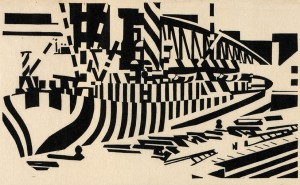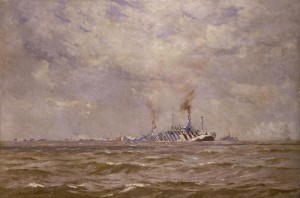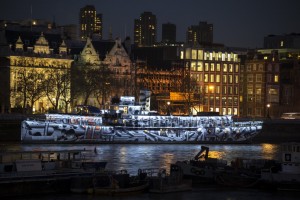By Juliet Wagner (Regular Contributor) and Margaret Walker
Anyone wandering along London’s South Bank since July 2014 will have noticed the remarkable ‘graffiti’ed ship docked across the river opposite the Tate Modern. The ship is one of three surviving First World War naval vessels, HMS President (1918). It was painted by the German artist Tobias Rehberger in the “dazzle style” invented during the First World War to camouflage merchant vessels and protect them from torpedo attacks.
Razzle Dazzle
After the declaration of unrestricted submarine warfare by Germany in January 1917, the British navy was acutely aware of the need for camouflage to protect ships crossing the Atlantic and the Channel with supplies. Attempts to make the ships less visible proved unsuccessful, and the artist Norman Wilkinson, then serving in the Navy, instead proposed the “Dazzle” technique. The premise behind Dazzle was that bold patterns and stripes could create optical illusions that would trick the human eye, and disrupt the ability of the German torpedo operator –viewing from a periscope—to predict where to shoot. (Operators had to estimate size, speed, direction of travel, and distance from the target ship to calculate where it would be when the torpedo reached it, and consequently perception was crucial to an effective strike). Wilkinson worked with a team of five designers and 11 female art students in a workshop in the Royal Academy in London to create small wooden prototypes, and a miniature periscope through which to view them, as King George V did when he visited the studio in 1918.
Into the Vortex

In Dry Dock 1918. Woodcut paper. Wadsworth, Edward Alexander (ARA) (1889 – 1949) http://www.1418now.org.uk/commissions/dazzle-ships/background/
Once the British Admiralty chose to adopt the Dazzle technique for merchant vessels in October 1917, Wilkinson appointed the artist Edward Wadsworth to oversee the painting in the shipyards in Liverpool and Bristol. Wadsworth had been a major figure in the Vorticist avant-garde art movement, and the similarity of Vorticism to the Dazzle designs is striking, suggesting that Wadsworth’s influence on the Dazzle ships was substantial. Margaret Walker has argued that Wilkinson not only hired Wadsworth based on his familiarity with Wadsworth’s pre-war artwork, but that the Dazzle ship’s Vorticist-looking designs played a central role in the “mainstreaming” of modernist visual culture in Great Britain. The modernism of the Dazzle ships was certainly not lost on educated contemporaries: one New York journalist quipped in reference to Marcel Duchamp’s “Nude Descending a Staircase” (1912) that the Dazzle Ship rather resembled “A Drunken Sailor Falling down a Hatchway.” The Dazzle camouflage technique was employed by American merchant vessels too, and was known in the USA as “Razzle Dazzle.” Although it is now most closely associated with ships, it was applied in other contexts too.
“A Flock of sea-going Easter Eggs”

© IWM (Art.IWM ART 4030) NORMAN WILKINSON image: A view of a distant convoy of ‘dazzle’ painted camouflaged ships at sea. By day, the ships are obviously visible, though from a distance the ‘dazzle’ effect stills works to confuse the number and outline of the different ships in the convoy. Imperial War Museum, Art Section commission
Rehberger’s South Bank dazzle ship is striking enough alone, but the technique was considered most effective for convoys, functioning like the stripes on a herd of zebra to confuse a predator and make individuals hard to identify and target. A convoy of dazzle ships in dock must have been a remarkable sight: a contemporary journalist described a group as a: “a flock of sea-going Easter Eggs.” Data collected by the British Navy suggested that Dazzle was only modestly successful at protecting convoys, but the practice was continued for reasons of morale, and by the end of the war, there were 2,300 dazzle ships in service, each with a unique Dazzle design.
Margaret Walker’s MSc thesis at the University of Edinburgh is entitled “Art of Illusion: Vorticism, Dazzle Ships and the Mainstreaming of Modern Art in Britain during the Great War” (August 2013)
On the history of camouflage, see: Roy R. Behrens, Camoupedia: A Compendium of Research on Art, Architecture and Camouflage (Bobolink Books, 2009)
Tobias Rehnberger’s Dazzle Ship will be docked opposite the Tate Modern until July 2015:
http://www.1418now.org.uk/commissions/dazzle-ship-london/
Margaret Walker is the art curator assistant at the Vanderbilt Fine Arts Gallery. Before gaining her MSc in History of Art, Theory and Display at Edinburgh University, she studied History at Princeton University.

